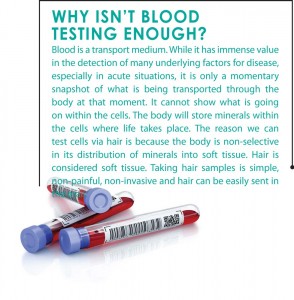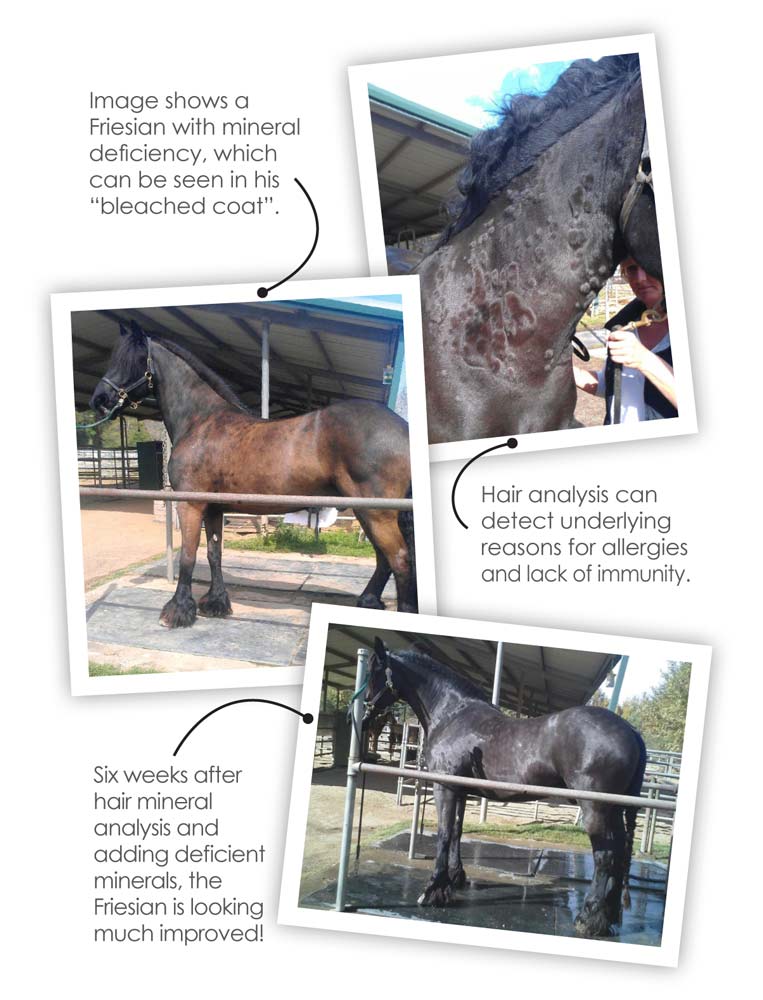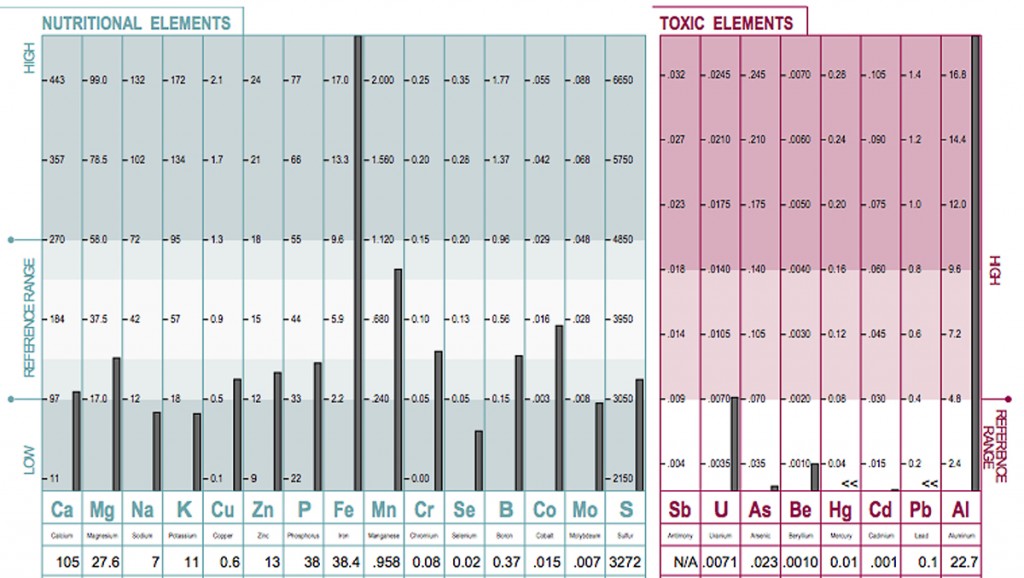Tissue Mineral Analysis

Mineral analysis, a hairy tool for preventive health.
When Gold Medalist and three-time National Dressage Competitor Shannon Peters showed her nine-year-old Grand-Prix horse Flor De Selva in 2009, she had no idea that Lyme disease and chronic weakening would soon force her to retire the Westphalian gelding.
The fat deposits on Flor De Selva’s body, along with a cresty neck, hinted at metabolic issues. When we started his recovery program in the fall of 2014, after five years of stall rest(!), he also showed a bleached coat and Cushing’s-like symptoms. He was so weak that walking out of his stall produced labored breathing.
Searching for answers
In an admirable leap of faith, and against all odds, Shannon agreed to a recovery attempt based on the findings of hair mineral analysis. Repeated serum analyses had not shown any significant indications of metabolic syndrome or other endocrine disease. However, the hair analysis pointed to a weakened endocrine system, lack of gastrointestinal absorption, and deficiencies in essential minerals. I felt that the possibility of recovery for Flor De Selva was far-fetched, but the slightest spark of hope created incredible determination in Shannon.
mineral analysis. Repeated serum analyses had not shown any significant indications of metabolic syndrome or other endocrine disease. However, the hair analysis pointed to a weakened endocrine system, lack of gastrointestinal absorption, and deficiencies in essential minerals. I felt that the possibility of recovery for Flor De Selva was far-fetched, but the slightest spark of hope created incredible determination in Shannon.
For the next six months, supported by a team of nutritionists, veterinarians, farriers and body workers, Shannon dedicated herself to successfully bringing Flor De Selva back to health and performance. His amazing comeback Grand Prix performance in April of 2015 at the Del Mar Nationals is a stunning tribute to one horse owner’s faith, the body’s incredible capacity for recovery, and the power of team work among people on same mission.
It also shows the potential of hair mineral analysis, though at the same time we do need to keep this tool’s limits in mind. We do come across quite a few cases like Flor De Selva, but hair analysis is not a cure-all. It does well as a complementary tool along with a good clinical exam, nutritional evaluation, blood work and critical study of the horse’s history. In this context, hair mineral analysis can be very powerful for balancing underlying factors for health, optimum wellness and performance.
Hair analysis — looking under the surface of health and performance
Being a responsible equestrian implies an internal worry-and-alert attitude when it comes to the well-being of our horses. The absence of disease does not mean optimum wellness. Sometimes we know that something is going “off” with our horses, even though conventional diagnostics cannot find anything yet. Over the decades, my veterinary career has shifted from “treating dis-ease” to developing a proactive approach for preventive care and early detection. On this quest, I came upon hair mineral analysis, also called “tissue mineral analysis” (TMA). For many years, hair analysis has proven valuable in prevention, and as demonstrated with Flor De Selva, in the detection of underlying chronic issues.
Why are minerals so important?
To understand hair mineral analysis, we have to know more about minerals, their power, function and behavior. Minerals are needed for life and health. A few common minerals include calcium, phosphorus, magnesium, sodium, potassium, selenium and sulfur. In total, the body needs about 60 minerals. Double Nobel Laureate Linus Pauling stated: “One could trace every disease and every ailment to a mineral deficiency.”
Soul energy can leave a body in an instant, resulting in immediate death. Deprivation of air gives us a few minutes to live. We can compensate for a lack of water for a few days. The rest of the body is made of protein and minerals. If the body is deprived of proteins, it might take a few weeks for the body to expire. Minerals represent the deepest layer of physical existence and the body reacts the slowest to their deprivation. Depending on the mineral, it can take months to years to manifest a clinical problem from an imbalance.
For example, we often see a phenomenon I call “import shock” in imported horses. This typical pattern of problems starts anywhere between six to 18 months after import, and results from drastic changes in the minerals found in soils and feeds. Once “import shock” has manifested, it can take months to years to rebalance the minerals. If a horse shows mineral imbalances related to imbalanced organ function, it will most likely take the body several months to self-heal, provided that the program is followed diligently and the right things are done.
Minerals as markers
Minerals are needed for all organ functions; at the same time, their levels also reflect how those organs are functioning. This two-way street turns tissue mineral analysis into a complex process demanding the correct interpretation for cause and effect. Every organ has a mineral profile or “thumb-print” from which we can draw conclusions on its function by analyzing how the organ treats certain minerals. That means there can be different reason for improper levels of a mineral in the body’s cells. These reasons can include dietary imbalances, problems in gastrointestinal absorption, or improper function of the organs primarily handling the mineral.
If an organ is not working properly and this results in a mineral deficiency, we cannot just add the deficient mineral to make the organ work. If the required amount and ratio of these minerals is contained in a horse’s feed, yet show deficient in his cells via hair analysis, other reasons for the deficit are likely and need to be addressed. We have to first restore the function of the organ. The minerals sodium and potassium are good examples. In acute stress, the body responds by increasing adrenal function. The adrenals are the “chemical brains” of the body and are tiny glands sitting right next to the kidneys. One of the results of acute stress is the retention of sodium and potassium in the body’s cells. If the stress becomes chronic, intracellular sodium and also potassium levels will drop. To restore the proper levels, we have to reduce stress and recover the whole body.
What can hair analysis show us?
A hair analysis reflects the average metabolism in the body cells over the period it took to grown the length of hair tested, usually about two to three months. We can see nutritional deficits, levels of essential minerals, heavy metal toxicity and important mineral ratios. Comparing the feed intake with the cellular content will shed light on the absorption rate of nutrients. In a nutshell, hair analysis will give you a good impression of your horse’s overall condition even before symptoms show up. Ongoing problems like lack of muscle or energy, lethargy, missing topline, disturbances in the gastrointestinal tract, allergies, coughs, endocrine tendencies, chronic body soreness, tying-up, skin irritations, unusual licking habits, irregular cycles or even frequent ulcers may all have their root in a nutritional and/or mineral imbalance.
How it works
About a teaspoon of mane hair is required, approximately ½” long, taken with stainless  steel scissors from different parts along the crest, as close to the body as possible. The recent outgrown hair is kept for the sample and the older tips are cut off and discarded. Ideally, the hair should not be shampooed, conditioned or fly-sprayed within the last three days.
steel scissors from different parts along the crest, as close to the body as possible. The recent outgrown hair is kept for the sample and the older tips are cut off and discarded. Ideally, the hair should not be shampooed, conditioned or fly-sprayed within the last three days.
The sample is sent to the lab where it will be ground up and processed via induction-coupled plasma (ICP) mass spectroscopy. Depending on the provider, it can take a few weeks to get the report back. Quite a few online sources offer hair analysis for a seemingly reasonable amount of money. But the real price factor is that you will either be left on your own with the results, or the advice provided will be drawn from the hair report only. Therefore, it is recommended to choose practitioners who offer hair analysis in conjunction with other methods of evaluation. Two equine-specific practitioners are Equolution (equolution.com), and De Paolo Equine Concepts (depaoloequineconcepts.com).
In closing, while hair analysis is not a cure-all or an appropriate diagnostic for acute cases, it can be a good marker for your horse’s current health, and helpful in determining the cause of chronic mystery health challenges.

Cellular (hair) analysis graph showing levels of nutritional and toxic elements. Examples: Iron (Fe) overload which has been related to triggering equine insulin resistance. Low electrolytes (sodium and potassium, Na and K) as a reflection of chronic stress. Selenium (Se) deficiency as possible reason for a weak immune system. Environmental contamination with Aluminum (Al).
Acknowledgments: My thanks go to Shannon Peters (San Diego, CA), Mark Silverman, DVM (San Diego, CA), Sossiti Gargiulo (Ventura, CA), Trace Elements (Addison Texas), and Jil Beltran (Fallbrook, CA).
